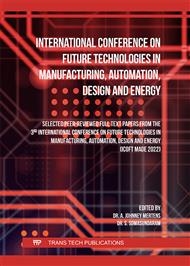[1]
Li, S., Chen, Y., Zhou, X., Kang, J., Huang, Y., & Deng, H. (2019). High-strength titanium alloy/steel butt joint produced via friction stir welding. Materials Letters, 234, 155-158.
DOI: 10.1016/j.matlet.2018.09.094
Google Scholar
[2]
Li, S., Chen, Y., Kang, J., Huang, Y., Gianetto, J. A., & Yin, L. (2019). Interfacial microstructures and mechanical properties of dissimilar titanium alloy and steel friction stir butt-welds. Journal of Manufacturing Processes, 40, 160-168.
DOI: 10.1016/j.jmapro.2019.03.015
Google Scholar
[3]
Gotawala, N., & Shrivastava, A. (2020). Microstructural analysis and mechanical behavior of SS 304 and titanium joint from friction stir butt welding. Materials Science and Engineering: A, 789, 139658.
DOI: 10.1016/j.msea.2020.139658
Google Scholar
[4]
Ishida, K., Gao, Y., Nagatsuka, K., Takahashi, M., & Nakata, K. (2015). Microstructures and mechanical properties of friction stir welded lap joints of commercially pure titanium and 304 stainless steel. Journal of Alloys and Compounds, 630, 172-177.
DOI: 10.1016/j.jallcom.2015.01.004
Google Scholar
[5]
Wu, A., Song, Z., Nakata, K., Liao, J., & Zhou, L. (2015). Interface and properties of the friction stir welded joints of titanium alloy Ti6Al4V with aluminum alloy 6061. Materials & Design, 71, 85-92.
DOI: 10.1016/j.matdes.2014.12.015
Google Scholar
[6]
Dressler, U., Biallas, G., & Mercado, U. A. (2009). Friction stir welding of titanium alloy TiAl6V4 to aluminium alloy AA2024-T3. Materials Science and Engineering: A, 526(1-2), 113-117.
DOI: 10.1016/j.msea.2009.07.006
Google Scholar
[7]
Song, Z., Nakata, K., Wu, A., Liao, J., & Zhou, L. (2014). Influence of probe offset distance on interfacial microstructure and mechanical properties of friction stir butt welded joint of Ti6Al4V and A6061 dissimilar alloys. Materials & Design, 57, 269-278.
DOI: 10.1016/j.matdes.2013.12.040
Google Scholar
[8]
Li, B., Zhang, Z., Shen, Y., Hu, W., & Luo, L. (2014). Dissimilar friction stir welding of Ti–6Al–4V alloy and aluminum alloy employing a modified butt joint configuration: Influences of process variables on the weld interfaces and tensile properties. Materials & Design, 53, 838-848.
DOI: 10.1016/j.matdes.2013.07.019
Google Scholar
[9]
Kar, A., Choudhury, S. K., Suwas, S., & Kailas, S. V. (2018). Effect of niobium interlayer in dissimilar friction stir welding of aluminum to titanium. Materials Characterization, 145, 402-412.
DOI: 10.1016/j.matchar.2018.09.007
Google Scholar
[10]
Kar, A., Suwas, S., & Kailas, S. V. (2018). Two-pass friction stir welding of aluminum alloy to titanium alloy: a simultaneous improvement in mechanical properties. Materials Science and Engineering: A, 733, 199-210.
DOI: 10.1016/j.msea.2018.07.057
Google Scholar
[11]
Chen, Y., Liu, C., & Liu, G. (2011). Study on the joining of titanium and aluminum dissimilar alloys by friction stir welding. The Open Materials Science Journal, 5(1).
DOI: 10.2174/1874088x01105010256
Google Scholar
[12]
Fu, B., Qin, G., Li, F., Meng, X., Zhang, J., & Wu, C. (2015). Friction stir welding process of dissimilar metals of 6061-T6 aluminum alloy to AZ31B magnesium alloy. Journal of Materials Processing Technology, 218, 38-47.
DOI: 10.1016/j.jmatprotec.2014.11.039
Google Scholar
[13]
Kwon, Y. J., Shigematsu, I., & Saito, N. (2008). Dissimilar friction stir welding between magnesium and aluminum alloys. Materials Letters, 62(23), 3827-3829.
DOI: 10.1016/j.matlet.2008.04.080
Google Scholar
[14]
Azizieh, M., Alavijeh, A. S., Abbasi, M., Balak, Z., & Kim, H.S. (2016). Mechanical properties and microstructural evaluation of AA1100 to AZ31 dissimilar friction stir welds. Materials Chemistry and Physics, 170, 251-260.
DOI: 10.1016/j.matchemphys.2015.12.046
Google Scholar
[15]
Liang, Z., Chen, K., Wang, X., Yao, J., Yang, Q., Zhang, L., & Shan, A. (2013). Effect of tool offset and tool rotational speed on enhancing mechanical property of Al/Mg dissimilar FSW joints. Metallurgical and Materials Transactions A, 44, 3721-3731.
DOI: 10.1007/s11661-013-1700-4
Google Scholar
[16]
Muthu, M. F. X., & Jayabalan, V. (2015). Tool travel speed effects on the microstructure of friction stir welded aluminum–copper joints. Journal of Materials Processing Technology, 217, 105-113.
DOI: 10.1016/j.jmatprotec.2014.11.007
Google Scholar
[17]
Fotouhi, Y., Rasaee, S., Askari, A., & Bisadi, H. (2014). Effect of transverse speed of the tool on microstructure and mechanical properties in dissimilar butt friction stir welding of al5083–copper sheets. Engineering Solid Mechanics, 2(3), 239-246.
DOI: 10.5267/j.esm.2014.3.001
Google Scholar
[18]
Wang, H., Qin, G., Geng, P., & Ma, X. (2020). Interfacial microstructures and mechanical properties of friction welded Al/steel dissimilar joints. Journal of Manufacturing Processes, 49, 18-25.
DOI: 10.1016/j.jmapro.2019.11.009
Google Scholar
[19]
Yazdipour, A., & Heidarzadeh, A. (2016). Dissimilar butt friction stir welding of Al 5083-H321 and 316L stainless steel alloys. The International Journal of Advanced Manufacturing Technology, 87, 3105-3112.
DOI: 10.1007/s00170-016-8705-2
Google Scholar
[20]
Derazkola HA, Khodabakhshi F. Underwater submerged dissimilar friction-stir welding of AA5083 aluminum alloy and A441 AISI steel. Int J Adv Manuf Technol 2019; 102:4383–95
DOI: 10.1007/s00170-019-03544-1
Google Scholar
[21]
Xu, R. Z., Ni, D. R., Yang, Q., Xiao, B. L., Liu, C. Z., & Ma, Z. Y. (2018). Influencing mechanism of Al-containing Zn coating on interfacial microstructure and mechanical properties of friction stir spot welded Mg–steel joint. Materials Characterization, 140, 197-206.
DOI: 10.1016/j.matchar.2018.04.011
Google Scholar
[22]
Amini, A., Asadi, P., & Zolghadr, P. (2014). Friction stir welding applications in industry. Advances in friction-stir welding and processing, 671-722.
DOI: 10.1533/9780857094551.671
Google Scholar
[23]
Ronneteg, U. (2018, June). Friction stir welding of copper and its NDT-From novelty to highly-developed. In Proc. 12th Eur. Conf. Non-Destructive Test. (pp.11-15).
Google Scholar
[24]
Murray, D.L. (2005). Friction Stir Processing of Nickel-Aluminum Propeller Bronze in Comparison to Fusion Welds. NAVAL POSTGRADUATE SCHOOL MONTEREY CA DEPT OF MECHANICAL AND ASTRONAUTICAL ENGINEERING.
Google Scholar


